- Products
- Learn
- Local User Groups
- Partners
- More
This website uses Cookies. Click Accept to agree to our website's cookie use as described in our Privacy Policy. Click Preferences to customize your cookie settings.
- Products
- AI Security
- Developers & More
- Check Point Trivia
- CheckMates Toolbox
- General Topics
- Products Announcements
- Threat Prevention Blog
- Upcoming Events
- Americas
- EMEA
- Czech Republic and Slovakia
- Denmark
- Netherlands
- Germany
- Sweden
- United Kingdom and Ireland
- France
- Spain
- Norway
- Ukraine
- Baltics and Finland
- Greece
- Portugal
- Austria
- Kazakhstan and CIS
- Switzerland
- Romania
- Turkey
- Belarus
- Belgium & Luxembourg
- Russia
- Poland
- Georgia
- DACH - Germany, Austria and Switzerland
- Iberia
- Africa
- Adriatics Region
- Eastern Africa
- Israel
- Nordics
- Middle East and Africa
- Balkans
- Italy
- Bulgaria
- Cyprus
- APAC
Policy Insights and Policy Auditor in Action
19 November @ 5pm CET / 11am ET
Access Control and Threat Prevention Best Practices
Watch HereOverlap in Security Validation
Help us to understand your needs better
CheckMates Go:
Maestro Madness
Turn on suggestions
Auto-suggest helps you quickly narrow down your search results by suggesting possible matches as you type.
Showing results for
- CheckMates
- :
- Products
- :
- Network & SASE
- :
- Management
- :
- Re: Traffic is originating from a VS with the VSX ...
Options
- Subscribe to RSS Feed
- Mark Topic as New
- Mark Topic as Read
- Float this Topic for Current User
- Bookmark
- Subscribe
- Mute
- Printer Friendly Page
Turn on suggestions
Auto-suggest helps you quickly narrow down your search results by suggesting possible matches as you type.
Showing results for
Are you a member of CheckMates?
×
Sign in with your Check Point UserCenter/PartnerMap account to access more great content and get a chance to win some Apple AirPods! If you don't have an account, create one now for free!
- Mark as New
- Bookmark
- Subscribe
- Mute
- Subscribe to RSS Feed
- Permalink
- Report Inappropriate Content
Traffic is originating from a VS with the VSX internal communication address
And no, I do not have the 192.168.196.0/24 anywhere on my network as sk101448 Traffic is originating from a VS (virtual system) with the VSX internal communication address describes.
One of my clients has just reported seeing same issue in his environment and I've span-up the VSX VSLS cluster on ESXi to see what's what and am seeing same thing (each VS is active on a different cluster member):



and from practically identical VS on the same cluster:
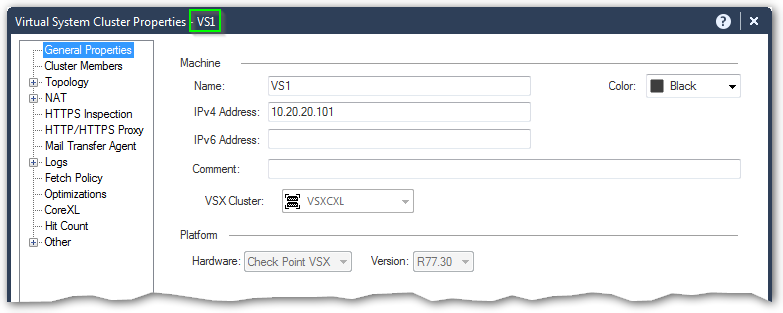
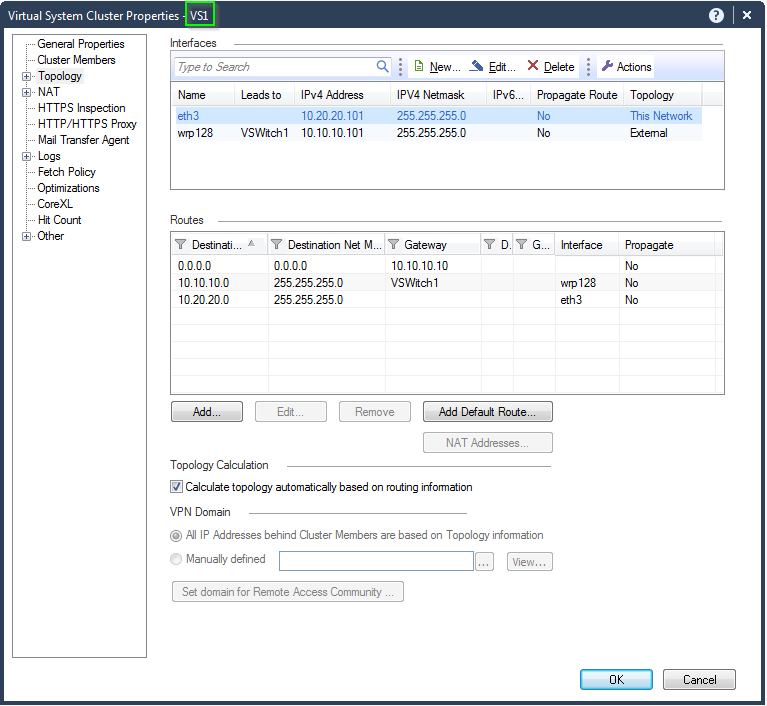

At the end of the previously mentioned sk, there is a workaround suggesting:
"If the 192.168.196.0/24 network can not be removed from the local network, then the 192.168.196.0/24 network must be removed from the NAT policy"
But I'd like to hear about the implications of doing it before trying it out.
27 Replies
- Mark as New
- Bookmark
- Subscribe
- Mute
- Subscribe to RSS Feed
- Permalink
- Report Inappropriate Content
From memory (and I might be wrong, will check tomorrow) to get around this I had to add explicit rule with the source of vs2 object and appropriate destination and port. How does your rule #1 look like?
- Mark as New
- Bookmark
- Subscribe
- Mute
- Subscribe to RSS Feed
- Permalink
- Report Inappropriate Content
Hi Kaspars.
Here it is:

Both VS' external ports are connected to the same VSWitch1.
- Mark as New
- Bookmark
- Subscribe
- Mute
- Subscribe to RSS Feed
- Permalink
- Report Inappropriate Content
Total bummer - log indexing crashed last night / yesterday at some point on MLM so it's on backfoot atm trying to catch up with logs ![]() so can't compare to mine and lab is dead atm too as I'm upgrading mgmt to R80.20... I'll check next week
so can't compare to mine and lab is dead atm too as I'm upgrading mgmt to R80.20... I'll check next week ![]()
- Mark as New
- Bookmark
- Subscribe
- Mute
- Subscribe to RSS Feed
- Permalink
- Report Inappropriate Content
Ouch! Good luck with recovery and the upgrade!
Are you doing export/import from 80.10 to 80.20?
I've done one recently in non-MDS environment.
So far so good, but that is a brand new infrastructure and the load on it is very light at the moment.
- Mark as New
- Bookmark
- Subscribe
- Mute
- Subscribe to RSS Feed
- Permalink
- Report Inappropriate Content
Actually I just completed full upgrade (primary/secondary MDS + MLM, 20 domains) using CPUSE. Took quite long but that's purely my lab ESX io speed and CPU limitations. Tested with pushing topologies and policies to 20 odd VSes on two different VSX clusters, looking good so far ![]() Will comment on upgrade documentation soon
Will comment on upgrade documentation soon ![]()
- Mark as New
- Bookmark
- Subscribe
- Mute
- Subscribe to RSS Feed
- Permalink
- Report Inappropriate Content
Knock on wood that this will become the way to do upgrade in the future.
CPUSE does work awesome, especially comparing to the mess we've had in pre-R77 years.
- Mark as New
- Bookmark
- Subscribe
- Mute
- Subscribe to RSS Feed
- Permalink
- Report Inappropriate Content
Same in my VSX. Originates from 192.168 and is NATed behind interface IP. when leaving the box Is it causing issues for your customer? Because if it isn't then there's nothing to worry about ![]()
- Mark as New
- Bookmark
- Subscribe
- Mute
- Subscribe to RSS Feed
- Permalink
- Report Inappropriate Content
I am trying to sort their issues out.
To the best of my understanding, they've had an issue with one of the VS in VSLS not failing over properly from one unit to the other.
They have rebuild the VS and now are observing this behavior. I think that VS itself is working now, but will have to verify.
They were just a bit stumped by this NAT action and, frankly, I am as well. Searching KB does not really return anything meaningful.
The thing is, these guys are relying on dynamic routing and I am a bit concerned how that will behave if the additional NAT is introduced on the traffic from VS that is also participates in the OSPF.
Check Point guys and girls, please chime in with explanation of the VSX VSLS implied XLATE behavior for virtual systems and it possible impact on dynamic routing.
Thank you,
Vladimir
- Mark as New
- Bookmark
- Subscribe
- Mute
- Subscribe to RSS Feed
- Permalink
- Report Inappropriate Content
But these internal VSX subnets 192.168 should not be distributed anywhere or part of anything. NAT does the correct thing and hides those. Why would you want to take away it?
You only want to see internal nets between nodes for clusterXL. that should be straight L2 VLAN
But then again we never run dynamic routing on VSX ![]() hard to comment
hard to comment
- Mark as New
- Bookmark
- Subscribe
- Mute
- Subscribe to RSS Feed
- Permalink
- Report Inappropriate Content
At this point, I'm thinking that it is working as designed and am not inclined to do anything about it, but simply would like to understand the mechanism of what is going on in the background better.
- Mark as New
- Bookmark
- Subscribe
- Mute
- Subscribe to RSS Feed
- Permalink
- Report Inappropriate Content
By the way, if all of them would've behaved identically, I could dig that, but as you can see in my screenshots, source for one of the VS is the assigned IP, for another is internal network address.
Perhaps there is a logic behind it, but I have no idea what it is.
- Mark as New
- Bookmark
- Subscribe
- Mute
- Subscribe to RSS Feed
- Permalink
- Report Inappropriate Content
The screen shots show log from the same VS2 but the direction is swapped, so yes this is what you would expect.
In the first you´re ping is from VS2 to VS1 with a source NAT on VS2
In the second you´re doing a ping from VS1 to VS2 with destination NAT on VS2
When you would look at the same log entries from VS1 you would see the opposite.
Regards, Maarten
- Mark as New
- Bookmark
- Subscribe
- Mute
- Subscribe to RSS Feed
- Permalink
- Report Inappropriate Content
Thank you for pointing this out!
For a second there, I thought that it all makes sense. Alas, it still does not.
As you have mentioned, when logs looked at from each Origin VS, Xlate (NAT) seem to be working correctly:
From VS1:
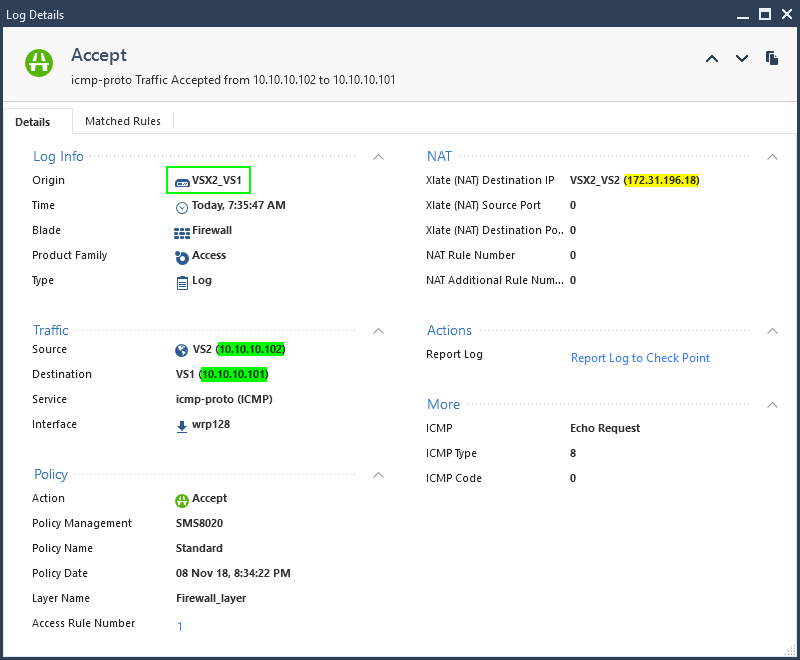
and from VS2:

But when I've pinged the external host from each VS, this is what I am seeing:
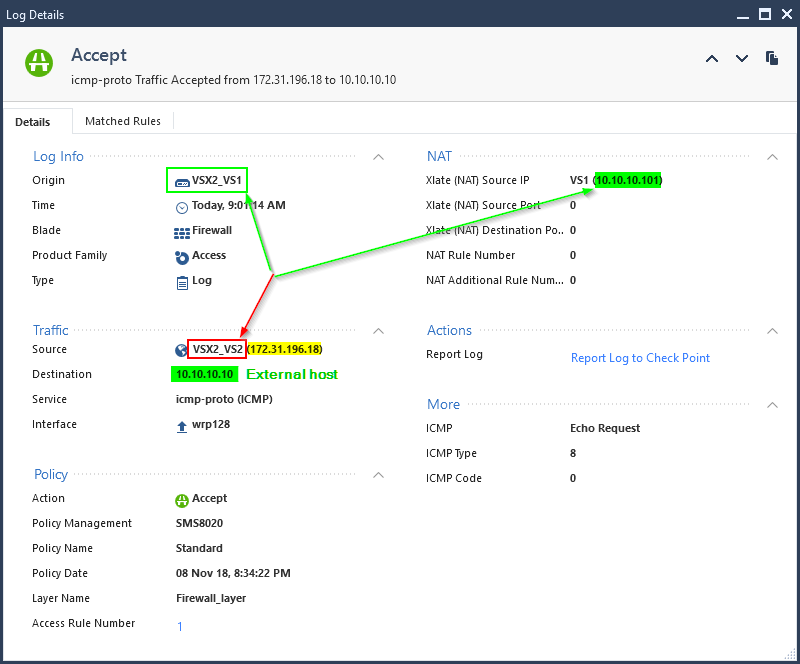
and:
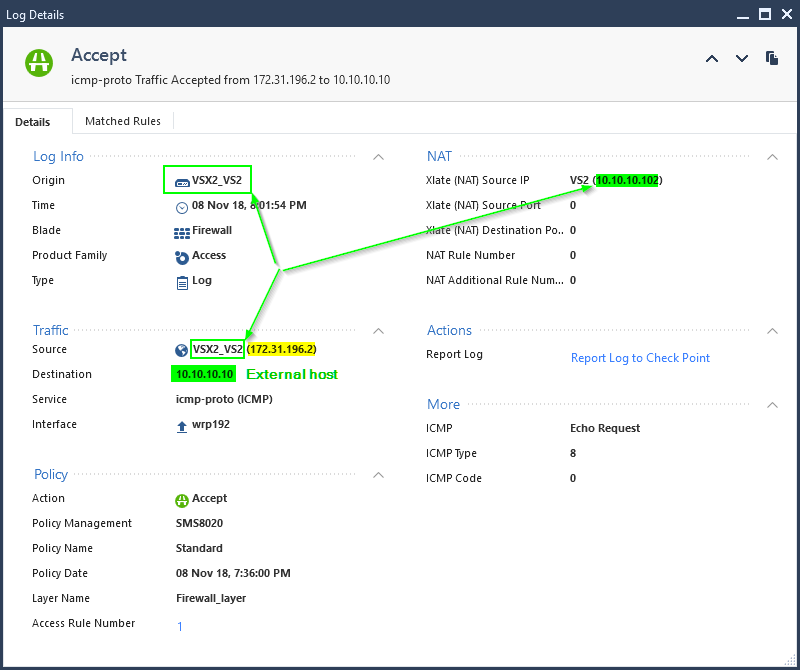
Unless I am reading this wrong, there is a discrepancy in Source and Origin data in the logs.
- Mark as New
- Bookmark
- Subscribe
- Mute
- Subscribe to RSS Feed
- Permalink
- Report Inappropriate Content
They all look perfectly fine to me, you will always see on the originating ping side VS, that it will do source NAT, this does not differ if you ping another VS or any other host.
When you ping another VS you will see the real IP (172.31.196.x) is being NATted to the VS official IP (the 10.10.10.x in above sample) before it leaves the first VS, on entry on the second VS the official IP 10.10.10.y will be destination NATted back to the real IP 172.31.196.y
Let's assume you have these IP's:
VS1 VS2 Host
real IP VS-IP real IP VS-IP IP
172.31.196.101 10.10.10.1 172.31.196.102 10.10.10.2 10.10.10.10
Now we start a ping from VS1 to VS2
Step 1 172.31.196.101 --> 10.10.10.2 from kernel to outbound interface
Step 2 10.10.10.1 --> 10.10.10.2 from interface to 'cable' leaving VS1
Step 3 10.10.10.1 --> 10.10.10.2 from 'cable' to interface entering VS2
Step 4 10.10.10.1 --> 172.31.196.102 from inbound interface to kernel
Now we start a ping from VS1 to Host
Step 1 172.31.196.101 --> 10.10.10.10 from kernel to outbound interface
Step 2 10.10.10.1 --> 10.10.10.10 from interface to 'cable' leaving VS1
Step 3 10.10.10.1 --> 10.10.10.10 from 'cable' to interface entering Host
Step 4 10.10.10.1 --> 10.10.10.10 from inbound interface to kernel
I hope this will make the picture complete and more understandable, when you go to a external host the 4th step will not be NATted.
To make it all even more crazy, when both VS'es would run on the same host you would see that both VS'es have the IP 172.31.196.101 as the VS will use 172.31.196.101 on host 1 and 172.31.196.102 on host 2.
Regards, Maarten
- Mark as New
- Bookmark
- Subscribe
- Mute
- Subscribe to RSS Feed
- Permalink
- Report Inappropriate Content
Maarten,
I think you meant to write 10.10.10.10 on the rite sight of your example above in "Now we start a ping from VS1 to Host " section. Please correct it for others to follow and for my poor brain not to get even more twisted over this ![]()
I still do not comprehend why source VSX_VS2 getting Source NATed to IP of the VS1:

I'll regroup and try to look at it tomorrow again.
Thank you for trying to help me to get to the bottom of this.
- Mark as New
- Bookmark
- Subscribe
- Mute
- Subscribe to RSS Feed
- Permalink
- Report Inappropriate Content
Previous post updated. 😉
I think this is due to the confusing naming you used, and the fact as I mentioned, the real IP's are reused in different VS' es and then you can be led to believe that the other VS is handling the traffic.
It does not make sense what I just wrote but I did see this before and it should not happen.
Regards, Maarten
- Mark as New
- Bookmark
- Subscribe
- Mute
- Subscribe to RSS Feed
- Permalink
- Report Inappropriate Content
OK then, just to nail it down, I'll rename the VS' to VSA and VSB and rerun the tests.
Pretty much, if the real IPs are being re-used dynamically by the VSX within clusters, we cannot rely on those at all for troubleshooting based on baseline data.
I would really like for someone in Check Point VSX R&D to get involved and explain the logic of this to us.
Dameon Welch-Abernathy, any chance you can rattle some cages to make it happen?
- Mark as New
- Bookmark
- Subscribe
- Mute
- Subscribe to RSS Feed
- Permalink
- Report Inappropriate Content
The internal communication VS communication addresses generally shouldn’t show up like this (to the best of my knowledge).
We probably need a TAC case.
- Mark as New
- Bookmark
- Subscribe
- Mute
- Subscribe to RSS Feed
- Permalink
- Report Inappropriate Content
My client, who has encountered his in production, should have an SR open.
I am working in the lab environment with no contracts.
Speaking of which: please let me know if you have figured out how to swing the accounts to another UC without the loss of content, history, and brag factors.
If I recall correctly, when you've tried doing something like that for Heiko, something didn't go as intended.
I will probably be better off moving to my own account, since I do carry a support contract.
- Mark as New
- Bookmark
- Subscribe
- Mute
- Subscribe to RSS Feed
- Permalink
- Report Inappropriate Content
I have swapped accounts for people in the past, it just has to be coordinated.
Contact me offline ![]()
- Mark as New
- Bookmark
- Subscribe
- Mute
- Subscribe to RSS Feed
- Permalink
- Report Inappropriate Content
OK. I am calling a BUG:
Environment consists of 2 VSX units in VSLS deployed on ESXi.
R80.20 management with R77.30 VSX'.
VSA 10.10.10.101
VSB 10.10.10.102
VSC 10.10.10.103
In this example, the ping from VSB to VSC, I am seeing Xlate (NAT) Destination IP labeled as VSX1_VSA.
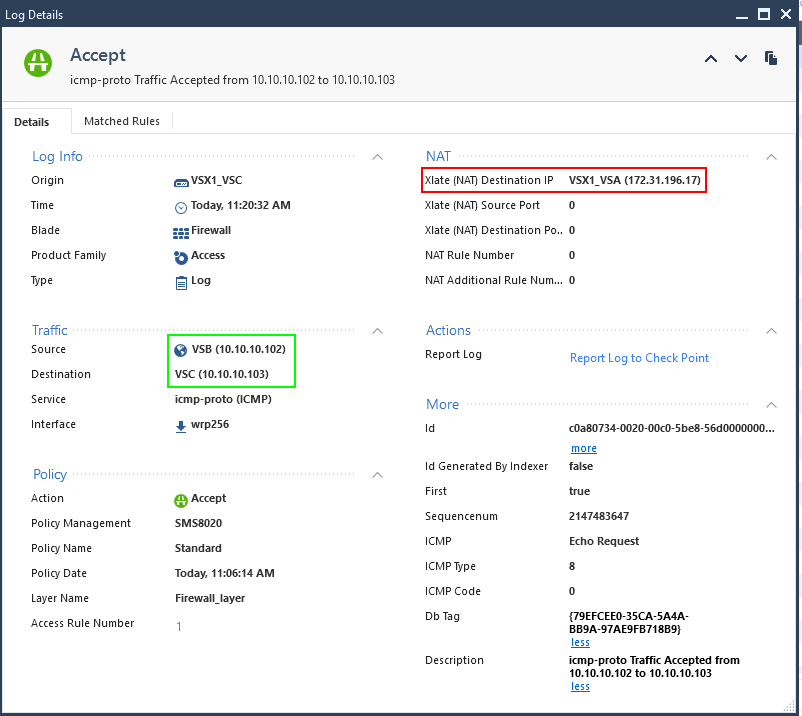
If the Internal Network IPs are actually rotated and are used dynamically, then in the NAT properties it may make sense to either not display the name of the VSX host and VS at all if those cannot be attributed correctly.
- Mark as New
- Bookmark
- Subscribe
- Mute
- Subscribe to RSS Feed
- Permalink
- Report Inappropriate Content
I'm getting consistent results from all VSes. VSX running R80.10, managed by R80.10 MDS.
Traffic always originates from "internal" VSX subnet and is translated to real interface IP
Ping from VS to VS

Ping to another IP

- Mark as New
- Bookmark
- Subscribe
- Mute
- Subscribe to RSS Feed
- Permalink
- Report Inappropriate Content
Perhaps VSX R80.10 behaves differently, but you see my results above with R77.30. Would be nice to get CP input on it.
- Mark as New
- Bookmark
- Subscribe
- Mute
- Subscribe to RSS Feed
- Permalink
- Report Inappropriate Content
Traffic should never be originating from those IPs.
Someone else I know saw a similar issue when they upgraded to R80.20 (don’t know the specifics).
We probably need a TAC case to gather the relevant debug.
- Mark as New
- Bookmark
- Subscribe
- Mute
- Subscribe to RSS Feed
- Permalink
- Report Inappropriate Content
This resembles a case we had on R77.10 which was resolved by TAC by adding the following:
- fwha_enable_state_machine_by_vs=1
- fwx_old_icmp_nat=0
Perhaps this can fix your issue?
- Mark as New
- Bookmark
- Subscribe
- Mute
- Subscribe to RSS Feed
- Permalink
- Report Inappropriate Content
Thank you Simon!
I'll give it a shot tomorrow and will let you know.
- Mark as New
- Bookmark
- Subscribe
- Mute
- Subscribe to RSS Feed
- Permalink
- Report Inappropriate Content
From my notes they are not applicable anymore ![]()
for old_icmp_nat

for state machine

I've removed them from our fwkern
Leaderboard
Epsum factorial non deposit quid pro quo hic escorol.
| User | Count |
|---|---|
| 25 | |
| 15 | |
| 11 | |
| 10 | |
| 6 | |
| 4 | |
| 3 | |
| 3 | |
| 3 | |
| 3 |
Upcoming Events
Thu 13 Nov 2025 @ 10:00 AM (CET)
Cloud Architect Series - Guarding Generative AI: Next-Gen Application Security with CloudGuard WAFThu 13 Nov 2025 @ 06:00 PM (COT)
Tegucigalpa: Risk Management al Horno: ERM, TEM & Pizza Night para la Comunidad CheckMatesThu 13 Nov 2025 @ 10:00 AM (CET)
Cloud Architect Series - Guarding Generative AI: Next-Gen Application Security with CloudGuard WAFFri 14 Nov 2025 @ 10:00 AM (CET)
CheckMates Live Netherlands - Veriti, Threat Exposure ManagementWed 19 Nov 2025 @ 11:00 AM (EST)
TechTalk: Improve Your Security Posture with Threat Prevention and Policy InsightsThu 20 Nov 2025 @ 05:00 PM (CET)
Hacking LLM Applications: latest research and insights from our LLM pen testing projects - AMERThu 20 Nov 2025 @ 10:00 AM (CST)
Hacking LLM Applications: latest research and insights from our LLM pen testing projects - EMEAThu 13 Nov 2025 @ 06:00 PM (COT)
Tegucigalpa: Risk Management al Horno: ERM, TEM & Pizza Night para la Comunidad CheckMatesThu 13 Nov 2025 @ 06:00 PM (COT)
Tegucigalpa: Risk Management al Horno: ERM, TEM & Pizza NightAbout CheckMates
Learn Check Point
Advanced Learning
YOU DESERVE THE BEST SECURITY
©1994-2025 Check Point Software Technologies Ltd. All rights reserved.
Copyright
Privacy Policy
About Us
UserCenter


